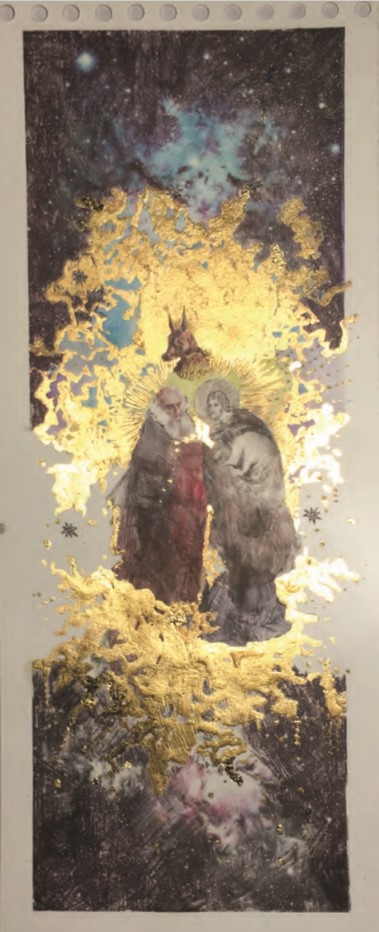Robert-David Kolić
Exhibition Statement for Mortal Window at The Bakery gallery
Robert Kolić is a Vancouver-based visual artist who structures collage as a codex of information, charting universal weather and aligning it with political events on earth. He studied Industrial Design at Emily Carr and attended Eindhoven Design Academy in the Netherlands as well as Capilano University in North Vancouver. Kolić amalgamates images in an exploration of cycles. He arranges information to make a visual, coded equation that diarizes a private theoretical or philosophical truth. His premiere collection, Versor Aspects/Higher Orders, is a counterspace timescale that acts as a reflective acquaintance, weathered friend, or wise seer that blends thought into quadrants of symbolic representations coalescing into a visual hysteria.
Historical events line up with aetheral movement, including transition of the planets that share the solar system with our Earth and Sun. He explores geometries of power by taking artists like Natale Bonifacio, a Croatian engraver who lived in Rome during the 16th century, and identifying his images of dragons and thunderbolts as symbols of aetherical force, then paralleling those images with contemporary symbols that communicate similar meanings. How did artists like Natale Bonifacio interpret physical forces of nature without present day tools? How did we understand the effects of the sun and express its movement with symbols? What languages did that build and when?
He tediously transfers images with xylene, pulling material from publications such as Time. Many of the sources Kolić pulls images from are aged and Xylene allows for an effective transfer with older inks, resulting in a fragmented or dynamic shift of original image to fresh paper. Solvent, (the xylene,) wets the back of the image and its pushed onto its new surface with various types of lead. This delicate method protects details.
As an experiment, Kolić began to record solar and planetary activity when working in a hospital. He charted solar weather, made predictions, and then asked Emergency Room staff about their shifts. There are colloquial idioms on the social effects of the moon’s orbit, but further to full moon fever, Kolić discovered fascinating connections between universal activity and human activity. By aligning solar activity with real life events, he marked correlations between higher flux solar and activity at the hospital.
Alexander Chizhevsky, a Russian biophysicist, founded heliobiology, or the study of the sun’s effect on biology. Chizhevsky proposed that geomagnetic storms resulting from sunspot-related solar flares affected everything from electricity, plane crashes, epidemics, and locust swarms to human mental activity. Increased negative ionization in the atmosphere increases collective human excitability. His theories claim human history is influenced by eleven-year peaks in sunspot activity, which have triggered humans en masse to act upon existing grievances by revolting, rebelling, or warring. We are in the 24th cycle.
During 1859, a geomagnetic solar storm, now referred to as the Carrington Event, blasted Earth’s magnetosphere with a coronal mass ejection. Taking only 17.6 hours to make the 150 million kilometre journey from Sun to Earth, between September 1-2, the storm affected almost the entire planet. Auroras played in the sky from the Caribbean to the Rocky Mountains, where they woke gold miners who began to prepare breakfast, thinking it was morning. Telegraph systems between Europe and America failed and shocked operators with electricity. Although, some operators continued to send and receive messages without connection to power supplies. A similar storm blew out of sunspots during 2012, but missed Earth due to our position in orbit.
Visions of places he travelled to in the Balkans during childhood are captured on paper. With family in Croatia, he visited during Communism, just before the Yugoslav wars, during the war, after the war, and nothing really changed. Different events happened, but without owning a bank account or property that plummeted in value, his childhood comprehension was limited. Buildings sagged with neglect from the 1990s on, because there was no money to do anything. Croatia’s history is fragmented, its importance dictated, its role always delegated, and its existence co-dependent. Its architecture is a physical collage of WW2 Communist monuments, Roman ruins that “escaped” pillage, medieval monuments that survived, and other points of invasion or migration that came and left. One era stacks on the next, like the natural accumulation of river sediment.
The recurring motif of religious iconography filters through his childhood visits. In the Balkans, religious iconography integrates into the aesthetic in the house. People may live with images that predate them by generations. Patinated scenes depicting Christ appearing to Mary Magdalene at the resurrection or Mother Mary cradling the infant Jesus are installations in the home. The frescos are beautiful pieces of artwork coded with complex narratives. In Versor Aspects, Higher Orders No. 11, Kolić plays with the tradition of gold in Catholic artwork. What gold moments in culture run counter to Catholicism? The association between gold and eternal life is mentioned in the Vedas, among the oldest sacred texts, with the Samhitas dated back to 1700-1100 BCE. The transmutation of converting mercury or base metals to gold appears in the Arthahastra treatsie, Buddhist texts from the second to fifth centuries, and Hermetic alchemists of the Middle Ages, who associated gold with a panacea, or elixir of life, that would cure all disease and bestow immortality. Solar events create electrical activity on earth, like thunderstorms. Electricity is associated with the science of alchemy. Kolić layers and distorts images or symbols that recur throughout history to place them in an objective context that allows for thought, rather than acceptance.
He considers and contrasts parallels in human thought from different points in time and geography to create chaotic mash-ups. The images chosen are weighted with history, architecture, science, thought, philosophy and language. They act as a tuning fork for some viewers, who share their knowledge and create an interactive, expanding, and diversifying web of learning. While Kolić builds the equation to answer a personal truth, the interpretation of the codex is alive.
